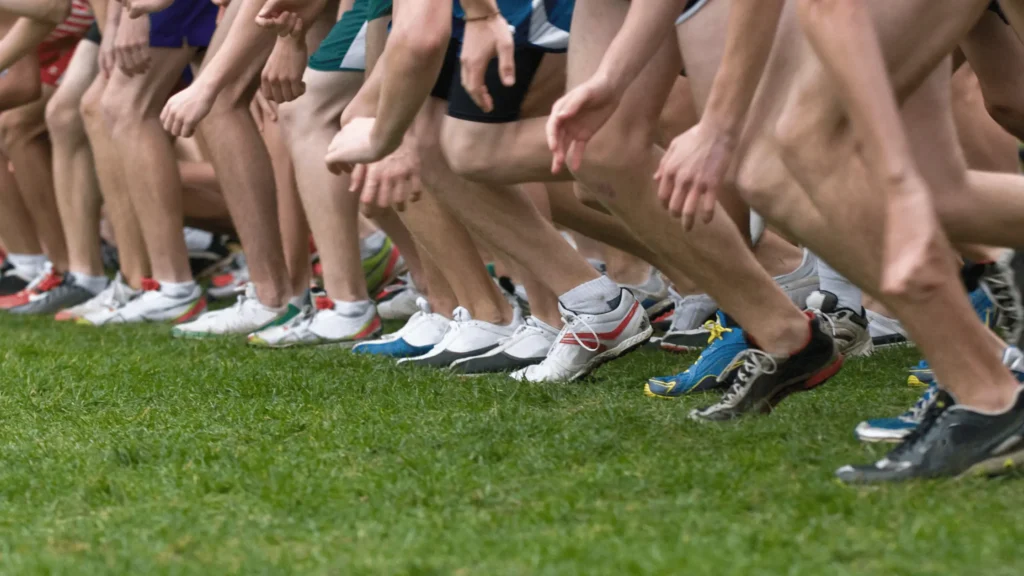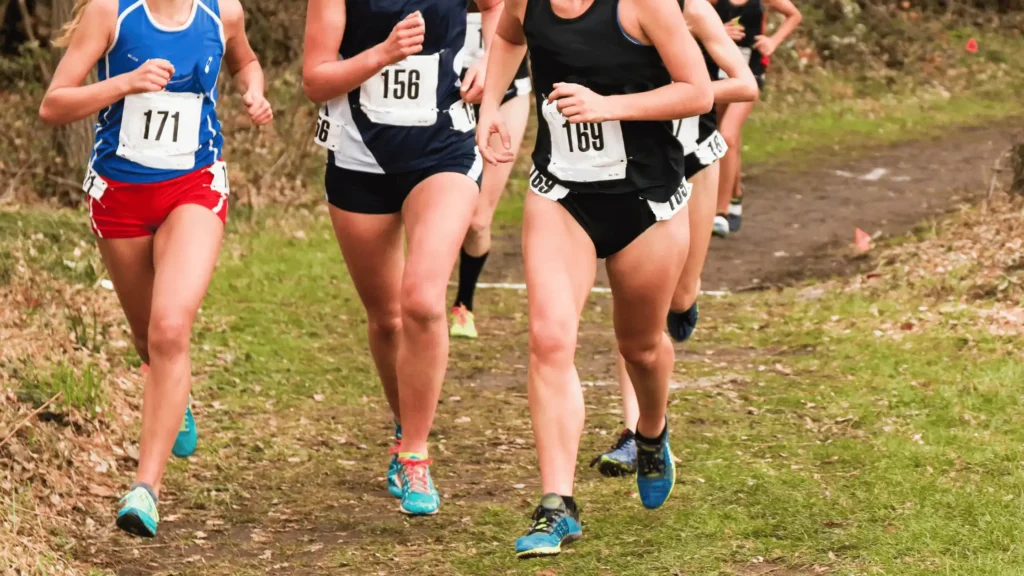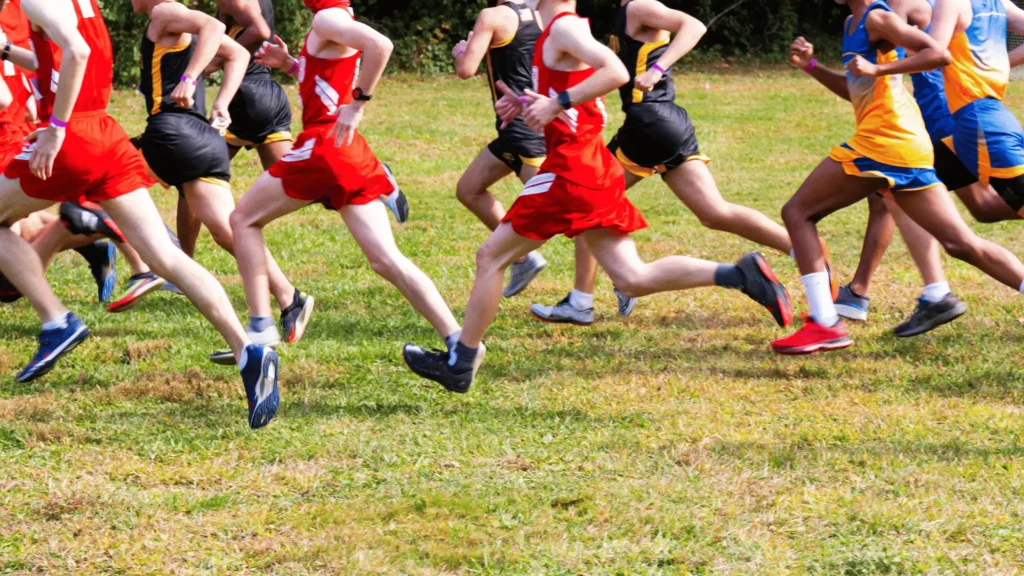Cross Country Chronicles: Crafting Success Stories in Cross Country and Track in 2024

Cross country involves long-distance running over natural terrain, while track is sprinting or distance running on an oval track. Cross country tests endurance over varied surfaces; track focuses on speed and technique on a standard track surface.
Table of Contents
Understanding the differences between cross country and track is essential for athletes who specialize in running, as well as for sports enthusiasts. Each discipline offers unique challenges and requires different types of training and skills. Cross country runners often face unpredictable conditions, such as changes in elevation, weather, and obstacles that require stamina and adaptability.
Track athletes, on the other hand, compete on a flat and predictable oval track that allows for high-speed races under controlled conditions. Events in track range from sprints to middle and long-distance runs, as well as relays and field events like jumping and throwing. Both sports have distinct seasonal focuses, with cross country typically taking place in the fall and track and field in the spring and summer, leading to diverse competition calendars for participating athletes.
Distinct Terrains And Courses

Distinct Terrains and Courses define the core of cross country and track events. Each environment brings unique challenges. In cross country, runners conquer natural terrain. Track athlete’s race on predictable surfaces. Understanding these landscapes highlights the sport’s essence.
Variety In Cross Country
Cross Country runners face a diverse range of terrains:
- Hills: Steep inclines test endurance.
- Mud: Slippery sections demand balance.
- Grass: Soft ground impacts speed.
This variety ensures no two courses are the same. Athletes must adapt strategies to the unique challenges they face with each new terrain.
Consistency On The Track
Track environments are standardized:
| Surface | Features |
|---|---|
| Synthetic | Uniform lanes and flat surfaces |
| Oval Shape | Predictable curves for perfect pacing |
Runners rely on consistent conditions. They perfect their form without unexpected obstacles. This uniformity allows for precise performance measurement and comparison.
Seasonal Changes And Weather Impact
As the seasons turn, athletes adapt to varying conditions in their sports. In cross country and track, weather changes bring unique challenges and adaptations. Understanding the seasonal impact helps athletes prepare for competition at their best.
Cross Country And The Elements
Cross country running takes place in autumn, a season known for its unpredictable weather. Races may encounter:
- Mud: Rain creates slippery courses, testing balance.
- Wind: Runners battle against or use wind to their advantage.
- Temperature fluctuation: Cold fronts can lead to sudden drops.
Preparation involves training in different weather to adapt better. Runners wear spiked shoes for grip and layers to manage body heat.
Track Conditions And Climate Control
Track meets often occur in spring and summer. Good weather means:
| Condition | Impact |
|---|---|
| Sunny and Dry | O ideal conditions for peak performance. |
| Heat | O requires hydration and cooling strategies. |
| Rain | O can cause slippery tracks, altering technique. |
Tracks offer more control over conditions, with weather-resistant surfaces and often seating for fans. Elite-level competitions may occur in stadiums with roofs, further insulating from weather’s impact.
Races And Distances Compared

Understanding the races and distances in cross country and track reveals their unique challenges. Each sport tests athletes in different ways. Compare race types and distances now.
Length Of Cross Country Events
Cross country races feature a range of lengths. These vary widely by level:
- High school events are usually 3 miles or 5 kilometers (3.1 miles).
- At collegiate levels, distances can range from 6k to 10k.
- Professional courses might extend up to 12 kilometers.
Terrain adds to the challenge. Runners face grass, hills, and mud. Each course is unique.
Standard Track Distances
Track events offer precise distances on an all-weather surface. Here are the standard track races:
| Event Type | Distance |
|---|---|
| Sprints | 100m, 200m, 400m |
| Middle Distance | 800m, 1500m |
| Long Distance | 5000m, 10000m |
| Hurdles | 100m/110m, 400m |
| Relays | 4x100m, 4x400m |
Track meets feature consistent conditions. Athletes know exact distances. No surprises.
Physical And Mental Demands
Cross Country and Track are both demanding sports.
Each one tests athletes in unique ways. Physical fitness is key.
But the mind must also be strong. Runners need different skills
for each sport. Let’s explore how endurance and speed set them apart.
Endurance In Cross Country
Cross Country challenges a runner’s stamina.
Courses are long. They have hills, mud, and sometimes streams.
Athletes run regardless of weather. Mental toughness is critical.
Runners keep pushing even when tired. The body and mind both need endurance.
- Varying terrains test balance and agility.
- Long distances require sustained energy.
- Pacing is crucial to maintain speed over time.
Speed And Technique On The Track
Track events are about pace and form.
Runners sprint or run specific distances. The races are on an oval track.
Athletes must master their stride and turns. Quick starts are important.
The focus is on technique and speed rather than endurance.
| Event | Focus Area |
|---|---|
| 100m Dash | Explosive Speed |
| 800m Run | Speed Endurance |
| Hurdles | Technique |
Training Regimens For Athletes

Runners vary in their goals, whether it’s the long, challenging stretches of cross country or the fast, intense sprints of track. Training regimens differ greatly between the two. Each requires a unique approach to harness an athlete’s full potential in their respective discipline.
Building Stamina For Cross Country
Cross country runners thrive on endurance. Their regimen focuses on long distances.
- Long Runs: Crucial for building aerobic capacity.
- Intervals: Enhance cardiovascular strength.
- Hill Workouts: Improve leg strength and resilience.
- Recovery Runs: Aid in muscle repair and endurance.
These elements work together for peak performance in longer races.
Developing Sprint Ability For Track
Track athletes require explosive power and speed. Their workouts reflect these needs.
| Activity | Purpose |
|---|---|
| Sprints | Boost fast-twitch muscle fibers for speed. |
| Weight Training | Build muscle power for quick starts. |
| Plyometrics | Enhance explosive strength. |
| Speed Drills | Improve agility and technique. |
Track athletes focus on these exercises to excel in short, swift competitions.
Footwear And Gear Essentials
Selecting the right footwear and gear is a pivotal decision for any runner. Whether hurtling through a cross country race or speeding around a track, your choice plays a huge role in performance and comfort.
Shoe Types For Varied Terrain
In cross country, athletes encounter a myriad of surfaces. Think mud, hills, and grass. Hence, their shoes must cater to these varied terrains.
- Spike shoes offer grip in grassy and muddy conditions.
- Trail running shoes provide extra traction for uneven paths.
- Durable rubber soles are a must to withstand diverse grounds.
Each course’s specifics dictate the choice of spiked or flat shoes. Lightness and stability are key.
Gear Optimized For Track Performance
Track athletes need shoes that enhance their speed and efficiency. Tracks are smoother and more predictable than cross country courses.
- Track spikes have a lighter build for quick sprints.
- Middle-distance spikes balance speed and comfort.
- Distance spikes focus on endurance and support.
Personal bests come from the merger of skill and optimized gear.
| Gear | Function | Best For |
|---|---|---|
| Sprinting spikes | Maximizes speed | Short track distances |
| Field event shoes | Supports jumps and throws | Field events on track |
| Compression wear | Improves circulation and recovery | Both cross country and track |
Don’t forget comfortable apparel that widens your range of motion.
Track uniforms are lightweight and aerodynamic, promoting top speeds. Breathable fabrics lead to enhanced performance.
Conclusion
Understanding the nuances between cross country and track shapes your athletic experiences. Each offers unique challenges and benefits, suited to diverse preferences and skills. As runners, knowing these distinctions helps us target our training and passion. Embrace your path, whether it’s the open trail or the oval track, and run your race with knowledge and heart.





